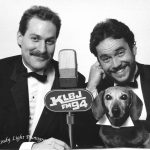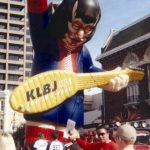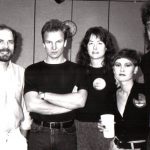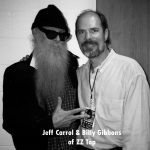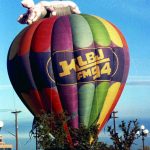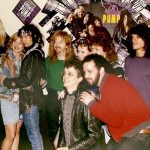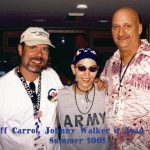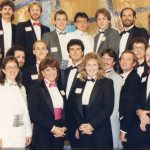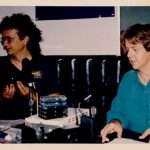History
KLBJ-FM signed on the air in Austin, Texas in 1972. Within two years, KLBJ grew to be Austin’s top rock station, where it has remained for half of a century. Experience has paid off! KLBJ-FM has a full-time air staff that averages 13 years with the station, 20 years in radio and 134 years of cumulative broadcast experience.
Our Legendary Staff
A big part of KLBJ’s continued success is the personalities behind the microphone. Over the last four decades we’ve boasted some of the best in the business!
(in no particular order)
- Johnny Walker (1991 – 2007) Afternoon Drive, Evenings
- Jeff Carrol (1982 – 2008) Middays, PD
- Peggy Simmons (1982 – 2004) Middays, Afternoon
- Mike Steele (2000 – 2006) Middays
- Charlie Hodge (2001 – 2011) Dudley and Bob Morning Show, Charlie Hodge Halftime Show
- Powermouth Patty
- Kirsten Winquist (2008 – 2012) Middays, Music Director
- Matt Sadler (2008 – 2011) Charlie Hodge Halftime Show
- Carissa McAtee (2008-2016) Dudley & Bob + Matt Associate Producer
- The Captain CJ Morgan (2011-2019) Middays, Evenings, Dudley & Bob + Matt Digital Producer
- Clark Ryan
- Ed Mayberry
Pictures
KLBJ: The Story of Austin Radio
Austin radio listeners first heard the spoken call letters “KTBC” on July 2nd, 1939. A continent away, Britain and Europe were on the brink of World War Two. Showing little more than potential, the fledgling radio station sputtered, financially, until December 1942, when a buyer, armed with limited capital, a dream, a journalism degree from the University of Texas, and no broadcasting experience, became the new licensee. Lady Bird Johnson had made the commitment to take KTBC radio – and blaze a path of broadcasting history.
It was the height of the war. Austin, like every other town in America, was affected by food and gasoline rationing – and was still in economic depression. A new automobile was nigh impossible to get, even if you had the required one thousand dollars. America – still in a furor over the Japanese “sneak attack” on Pearl Harbor – sent thousand upon thousand G.I.s into hand-to-hand combat on coral islands with strange-sounding names. American airmen were flying the first of the air Armadas of “Flying Fortresses” out of Britain to bomb Hitler’s Europe.
The struggling, exuberant KTBC was housed in modest second-story headquarters on Eighth Street, above Nixon-Clay Business College, across from the Courthouse. It moved to the Brown Building, a short move, Eighth and Colorado, in 1943. During this year, on August 29th, KTBC became Austin’s Columbia Broadcasting System affiliate. Austinites were constantly apprised of the state of the war, by Edward R. Murrow – “This is London” and by the voices of his superlative CBS team – Robert Trout, Richard C. Hottelet, Charles Collingwood, Charles Shaw, Larry LeSueur, and the perennial Douglas Edwards.
Aubrey Escoe, KTBC’s General Manager, ran the radio station – supported by a largely female staff replacing men gone to war. Among the distaff, a young Nellie Connally, who served admirably as wartime time sales representative. Austin’s Mayor was Tom Miller, who was no doubt proud that Austin’s population had risen to eighty-eight thousand, five hundred…….
KTBC broadcast the details of the invasion of Europe on “D” Day – 6th of June, 1944. Less auspiciously, this day heralded the hiring of medically discharged Richard Pryor from the U.S. Army Aircorps. Richard Pryor broadcast local news, played records, entertained, and took his fair share of tidying up the studios. It would be quite some time before he would wear the appendage of his father’s movie theater, and take the name “Cactus” into Texas legend……
All through this period, KTBC and Austin listeners suffered from programming time “gaps,” since its broadcasting frequency was shared with another radio station in College Station – the home of Texas A&M; University.
Harfield Weeden, doubling as Morning Personality was also General Manager. Harfield was later to move on to bigger things; Vice President, CBS programming, West Coast (L.A.).
The end of the war saw the men come home, and KTBC became staffed with many who would leave footprints in Austin and National history. Pat Adelman, General Manager, handed the guiding reigns to J.C. “Jesse” Kellam. J.C. Kellam was at the KTBC helm for many a year. John Connally, Bonner McLane, Jake Pickle – all served on KTBC’s staff. Time passed, and a young bright Texan hopeful talked his way into KTBC as announcer. Bill Moyers was on his way….
Technical development never ceased. A United States Army officer/technician, Major Armstrong, through inspiration viewed at the time as genius, envisioned the development of the Ultra High Frequency Band. Interference-free from static electricity, it became the wave(no pun intended) of F.M. (Frequency Modulation) broadcasting.
KTBC received its FM broadcasting permit on March 10, 1960.
August 1, 1966 – The tragedy of “The Shooting from the U.T. Tower.” A lone gunman, with an arsenal of weapons, began sniping at unwary students and teachers on the college campus. For one day in history, KTBC broadcast the news from its studios, and from Red Rover. The English-speaking world’s attention was riveted on Austin, Texas, as a young KTBC reporter, Neal Spelce, relayed the news of the shootings of over thirty innocent people. Crouching by the Red Rover news vehicle, Spelce warned KTBC’s listeners in agonized words – “Do not go near the U.T. Tower. There is a sniper at the Tower, shooting at will….
In KTBC studios, Paul Bolton, News Director, was at his post, as he had been continuously since 1946. As the list of victims was read to Bolton, he said, almost as matter of fact, “Read that list again, please. I think you have my grandson on that list.” Tragically, he was correct. Yet Paul Bolton stayed on the job – on the story, until the last details were broadcast – including the assault on the U.T. Tower, and the fatal shooting of the unbalanced, misfit ex-marine, Charles Whitman.
KTBC received a Peabody award. Neal Spelce, businessman, is still a voice in Austin.
Seven years later, July 15th 1973, the flag was lowered on the call letters, KTBC, and raised with the new letters, KLBJ.
This was perhaps, one of the few times that the presence of the President of the United States, Lyndon Baines Johnson, was felt by the radio station’s staff – or its audience.
As Cactus Pryor stated in the forward of his book Inside Texas, he has never been aware of any influence through the Johnson family of what – or what not – to say on the air.
At the time of the call letter change, FM as a broadcast medium was already making its move, simply by the listener’s awareness of music played without static interference, whether passing by power lines, or in heavily metalled building construction. Many stations experimented with the new medium, always with a music format, ranging all the way from classical music to ethnic folk music. KLBJ-FM experimented also. At one time a nucleus of female “disc-jockettes,” all from different countries, brought the musical wares of their native origins to Austin listeners.
It was a time when young people and their culture split from the mainstream. The “Summer of Love” in 1967 had divided a generation between “Top 40” and “Underground” music. FM was the perfect carrier for the counter-culture. “Underground” radio epitomized the experimental nature of America’s youth. The FM movement grew.
1974 – KLBJ-FM plunged boldly into the underground movement. This was also the time (post-Viet Nam) when early rock and roll fans of “Underground” radio became more conservative. “Underground” radio needed structure to reflect a maturing audience. Out of this structure came A.O.R. (Album-Oriented Rock).
1978 – As listener’s interests broadened to punk, new wave and jazz, KLBJ-FM evolved to a broader format to encompass all these genres.
By 1980, the punk/new wave fad had passed with its bests elements melding into the mainstream. The vocal youngsters of 1967 are the business people of today and KLBJ-FM has evolved into a true mass-appeal rock-and-roll station for adults. The best example of the effect of music on its diehard devotees was in December of 1980 when over 5,000 Austinites gathered at Zilker Park for a candlelight vigil upon hearing of John Lennon’s death.
KLBJ-FM has grown up with Austin and our commitment to local artists has been rewarded by our listener’s support. Throughout the 1990’s, KLBJ’s programming and personalities have been recognized as the best in the Austin Chronicle’s annual “Best of Austin” readers poll. In 1995 was chosen by Billboard Magazine as the “Rock Station of the Year”. KLBJ strives to stay on the cutting edge of today’s musical tastes. Our new home on the Internet, is another example of KLBJ-FM adapting to the changing times and needs of our listener’s. Our website viewers can now learn more about the on-air personalities, find out the latest news from the station and check out our current promotions anytime from their desktop computers. Now after FIFTY years, KLBJ-FM is clearly established as Austin’s Rock-and-Roll connection.

